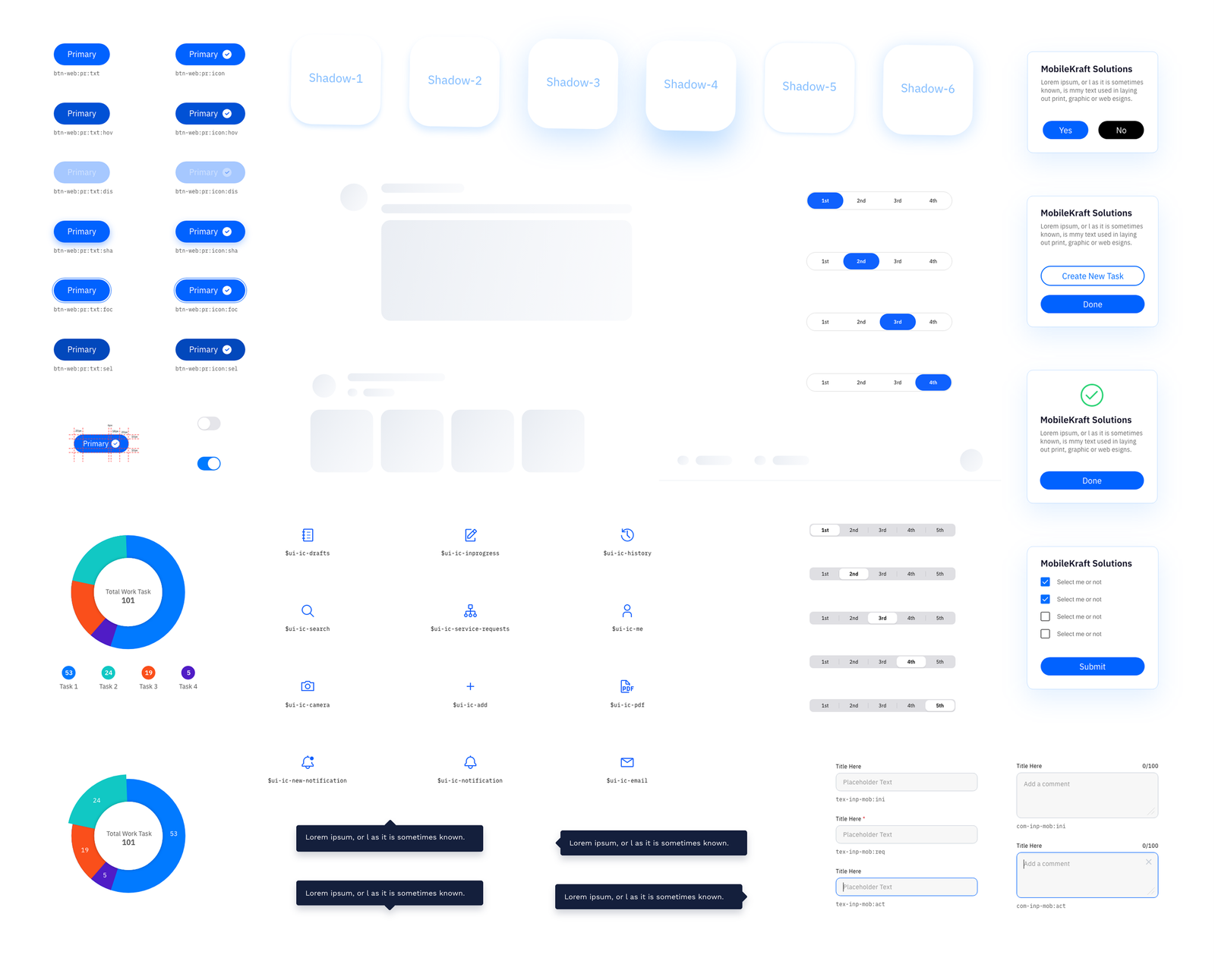Transformed IBM TRIRIGA ERP Apps for Enhanced UX/UI
Redesigned ecifm’s complex IBM TRIRIGA ERP applications to deliver a cohesive, modern UX/UI—unifying workflows and enhancing productivity across IWMS environments.
Read Case Study →
To accelerate MobileKraft’s mission of delivering seamless, scalable digital experiences, we set out to build a comprehensive design system as the foundation for all MK digital products. This system provides a unified set of design principles, reusable components, and clear documentation, ensuring every product reflects a consistent brand identity and user experience across platforms. By standardizing design and development processes, the design system streamlines collaboration, reduces time-to-market, and supports MobileKraft’s growth by making it easier to scale and adapt digital solutions for future needs.
As Senior Product Designer and Design System Lead, I owned the entire lifecycle of the design system—from initial research and strategy to component creation and final handoff—collaborating closely with cross-functional teams to ensure consistency, scalability, and successful adoption across products.
I was tired of these boring questions, so I took the initiative to create a design system. We all probably hate the questions below since they take most of the focus and time.

The MobileKraft design team struggles with fragmented design patterns and inefficient workflows, leading to inconsistent user experiences, increased rework, and slower product delivery. Without a unified design system, scaling and maintaining high-quality digital products across platforms remains a significant challenge.
The goal is to create a cohesive design system that elevates user experience, reinforces brand consistency, and speeds up product development by providing scalable, reusable design components and clear guidelines.
I began with research and stakeholder interviews to identify pain points and requirements. After defining the project scope, I adopted the Atomic Design methodology to systematically build the MK Design System—starting with basic UI atoms and progressing to complex templates and pages. This approach ensured a scalable, reusable, and consistent system, supported by thorough documentation and cross-team collaboration.
Conducted comprehensive research, including stakeholder interviews, team workshops, and usability assessments, to identify the unique needs and challenges of our enterprise environment. Analyzed existing design assets and industry best practices to ensure the new design system would address real user pain points, support complex workflows, and align with organizational goals.

Aligned the design system’s objectives with MobileKraft’s startup goals, emphasizing the need for scalability, design consistency, and streamlined product development. Clearly defined the scope to include essential components, guidelines, and documentation that would support cohesive and efficient design across all digital products.

Implemented the Atomic Design methodology—structuring components as atoms, molecules, organisms, templates, and pages—to build a scalable system tailored to MobileKraft’s needs.

Applied Atomic Design to structure atoms, molecules, and organisms, creating a scalable, consistent foundation for MobileKraft’s design system. This architecture offers a high-level overview of all components and key considerations, ensuring clarity and cohesion throughout the system.

Audited MK’s digital products to identify recurring elements, classifying them as atoms, molecules, and organisms. Evaluated each for scalability, reusability, and alignment with Atomic Design principles—while mapping foundational styles like colors, typography, and spacing into design tokens to ensure consistency across components.

Ensure every component is thoroughly documented in Zeroheight, providing clear implementation guidelines, usage instructions, behaviors, and variations. Documentation is tailored to support the development team, design team, and other stakeholders, making it easy for everyone to understand, use, and maintain the design system.

Educate the design and development teams about the Atomic Design methodology and the benefits of the design system. Conduct workshops and training sessions to encourage collaboration and ensure buy-in from all teams involved. Foster a culture of collaboration and continuous feedback.
Please note that, due to confidentiality restrictions, I am unable to share additional concept or final design materials.

Implementing the design system has established a consistent visual language across MobileKraft, strengthening brand recognition and trust. It streamlined design and development workflows, boosting efficiency and accelerating project delivery. The system also enhanced collaboration and communication, fostering alignment across teams. Additionally, it serves as a valuable resource for onboarding, helping new members quickly grasp our design principles. Overall, the design system drives a stronger brand, improved productivity, better user experiences, and a scalable foundation for future growth.
The MK design system has elevated our brand’s consistency and professionalism across platforms. It boosted our efficiency and streamlined project delivery. With a unified framework, our team collaborates more effectively. The system exceeded our expectations and is key to our future success.
Redesigned ecifm’s complex IBM TRIRIGA ERP applications to deliver a cohesive, modern UX/UI—unifying workflows and enhancing productivity across IWMS environments.
Read Case Study →